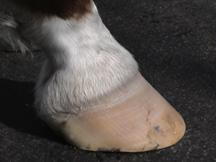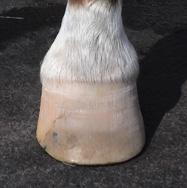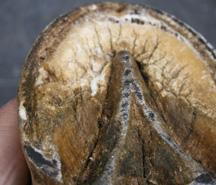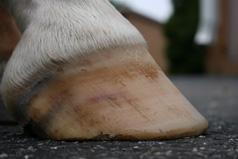- posted: Dec. 21, 2018
By February, 2007, almost 1 year after the shoes were removed due to white line disease, subsolar abscesses, bruising of the walls, hemorrhage in the laminae, black pus coming out all the nail holes , the right front foot is shown as finally clear of infection. The foot is white. No bruising. There is still black discoloration within the wall at the ground level. The toes are way too long, but at least there is some foot and some wall. The horse continues to be worked in hoofwing boots. Actually, he was becoming sound enough to ride barefoot in arenas with good footing, and outside in the fields. He was still sensitive on stones.
 February 21, 2007, Right front foot. No bruising. Still a significant indentation in quarter . Whole foot is too long, but I was glad there was foot, at all, so was fearful of taking too much off. The horse was sound.
February 21, 2007, Right front foot. No bruising. Still a significant indentation in quarter . Whole foot is too long, but I was glad there was foot, at all, so was fearful of taking too much off. The horse was sound.
 February 21, 2007. Right front foot. The shape is pretty decent. The hoof looks a little narrower than the coronary band, especially on medial side. At this point, though, I thought things were improving.
February 21, 2007. Right front foot. The shape is pretty decent. The hoof looks a little narrower than the coronary band, especially on medial side. At this point, though, I thought things were improving.
 June 4, 2007. The horse was finally sound to ride barefoot. So I took him to a show at a big and well known horse park. The footing in the arenas was fine. Getting to the arenas over the stone walks and drives was the tricky part. I showed the horse. When I got him back on the trailer I saw that he had put a stone through the sole on the lateral quarter of the right hind. On the left side of the foot you can see the triangular divot into the subsolar dermis. Now the foot was open to getting infected again, and it did, in spite of oral antibiotics, poultices, wraps, antibiotic ointments etc. I was not allowed to put hoofboots of any sort on Fabio’s feet to show him. Nailed on shoes were not an option as it had just taken me over a year to heal his feet from the damage nail on shoes had done to him. So I had to show him barefoot. And because he has weak, genetically poor quality hooves, in spite of everything I was doing daily to heal his feet, the soles were still so soft that a stone could go through them. You can see in the photo there are still no bars, and the sole is very cracked, but getting thicker.
June 4, 2007. The horse was finally sound to ride barefoot. So I took him to a show at a big and well known horse park. The footing in the arenas was fine. Getting to the arenas over the stone walks and drives was the tricky part. I showed the horse. When I got him back on the trailer I saw that he had put a stone through the sole on the lateral quarter of the right hind. On the left side of the foot you can see the triangular divot into the subsolar dermis. Now the foot was open to getting infected again, and it did, in spite of oral antibiotics, poultices, wraps, antibiotic ointments etc. I was not allowed to put hoofboots of any sort on Fabio’s feet to show him. Nailed on shoes were not an option as it had just taken me over a year to heal his feet from the damage nail on shoes had done to him. So I had to show him barefoot. And because he has weak, genetically poor quality hooves, in spite of everything I was doing daily to heal his feet, the soles were still so soft that a stone could go through them. You can see in the photo there are still no bars, and the sole is very cracked, but getting thicker.
 July 11, 2007. This is a photo of the right front foot, now bruised again from wearing a rubber boot with a metal screw in it for only an hour. After the June 4 experience, I began to get more upset. I needed something to protect my horse’s hooves. Easyboot bares boots looked like a good option, that might eventually be approved for use in Dressage competition. They had a cleaner design than the Hoofwings. They also had a cuff, and some metal screws and plates on the dorsal wall of the hoof at the quarters. I tried them on Fabio for an hour. When I took them off, I saw bruising of the hoof wall right under the metal screws. How could that little bit of pressure on a horse’s wall cause it to bleed? Well, as I said from the beginning, some horses have terrible feet. Not all horses can tolerate steel shoes or nails in their feet, or glue, or even metal screws and washers in a rubber boot which is pressing against the hoof wall. This 17 hand dressage horse has feet like butter!! Back to the drawing boards
July 11, 2007. This is a photo of the right front foot, now bruised again from wearing a rubber boot with a metal screw in it for only an hour. After the June 4 experience, I began to get more upset. I needed something to protect my horse’s hooves. Easyboot bares boots looked like a good option, that might eventually be approved for use in Dressage competition. They had a cleaner design than the Hoofwings. They also had a cuff, and some metal screws and plates on the dorsal wall of the hoof at the quarters. I tried them on Fabio for an hour. When I took them off, I saw bruising of the hoof wall right under the metal screws. How could that little bit of pressure on a horse’s wall cause it to bleed? Well, as I said from the beginning, some horses have terrible feet. Not all horses can tolerate steel shoes or nails in their feet, or glue, or even metal screws and washers in a rubber boot which is pressing against the hoof wall. This 17 hand dressage horse has feet like butter!! Back to the drawing boards
Part X will show more attempts at finding some sort of shoe to put on Fabio’s feet so that I could show him. In the meantime however, I was healing an abscessed right hind obtained while trying to show him barefoot, and two bruised front feet from trying a different type of boot on him.
Business Hours
8:30 am
6:00 pm
8:30 am
6:00 pm
8:30 am
6:00 pm
8:30 am
7:00 pm*
8:30 am
6:00 pm
8:30 am
12:00 pm
Closed
Closed
